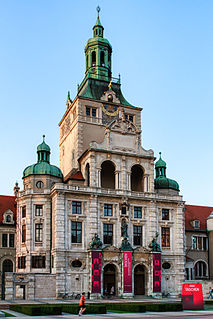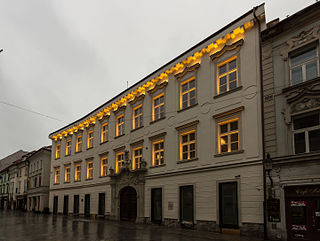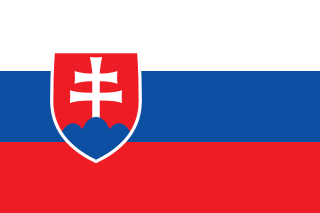
Old Town Hall is a complex of buildings from the 14th century in the Old Town of Bratislava, the capital of Slovakia. It is the oldest city hall in the country and it is one of the oldest stone buildings still standing in Bratislava, with the tower being built approximately in 1370. The town hall was created in the 15th century by connecting three townhouses, and then went through several reconstructions in the course of the centuries.

Faience or faïence is the conventional name in English for fine tin-glazed pottery on a buff earthenware body, at least when there is no more usual English name for the type concerned. The invention of a white pottery glaze suitable for painted decoration, by the addition of an oxide of tin to the slip of a lead glaze, was a major advance in the history of pottery. The invention seems to have been made in Iran or the Middle East before the ninth century. A kiln capable of producing temperatures exceeding 1,000 °C (1,830 °F) was required to achieve this result, the result of millennia of refined pottery-making traditions. The term is now used for a wide variety of pottery from several parts of the world, including many types of European painted wares, often produced as cheaper versions of porcelain styles.

Levoča is a town in the Prešov Region of eastern Slovakia with a population of 14,700. The town has a historic center with a well preserved town wall, a Gothic church with the highest wooden altar in the world, carved by Master Pavol of Levoča, and many other Renaissance buildings.
The Royal Pharmaceutical Society is the body responsible for the leadership and support of the pharmacy profession within England, Scotland and Wales. It was created along with the General Pharmaceutical Council (GPhC) in September 2010 when the previous Royal Pharmaceutical Society of Great Britain was split so that representative and regulatory functions of the pharmacy profession could be separated. Although membership of the Society is not a prerequisite for engaging in practice as a pharmacist within the United Kingdom, most practising pharmacists opt to join the Society because of the benefits offered by membership. Its predecessor the Pharmaceutical Society of Great Britain was founded on 15 April 1841.

Bratislava Castle is the main castle of Bratislava, the capital of Slovakia. The massive rectangular building with four corner towers stands on an isolated rocky hill of the Little Carpathians directly above the Danube river in the middle of Bratislava. Because of its size and location, it has been a dominant feature of the city for centuries.

Spišská Nová Ves (pronunciation ; is a town in the Košice Region of Slovakia. The town is located southeast of the High Tatras in the Spiš region, and lies on both banks of the Hornád River. It is the biggest town of the Spišská Nová Ves District. The population is around 37,000 inhabitants.

The Bavarian National Museum in Munich is one of the most important museums of decorative arts in Europe and one of the largest art museums in Germany. Since the beginning the collection has been divided into two main groups: the art historical collection and the folklore collection.

Kaplna is a village and municipality in western Slovakia in Senec District in the Bratislava Region. It is located about ten kilometres north-east of Senec on a road connecting Senec with Trnava.

Holíč is a town in western Slovakia.

Gánovce is a village in the Poprad District of the Prešov Region in northern Slovakia, situated 3 km south-east from the town of Poprad.

The Mauksch–Hintz House is a historic building on the Main Square of Cluj-Napoca, Romania, which houses the first pharmacy in the city.
The Pharmazie-Historisches Museum in Basel, Switzerland, is dedicated to pharmaceutical history and houses one of the world’s largest collections on the subject. It features ceramic pharmaceutical vessels, complete pharmacy interiors, an alchemistic laboratory, mortars, first-aid kits, books, medications from bygone eras and everything related to the historic manufacture of pharmaceuticals.

The Trinitarian Church or Trinity Church, full name Church of Saint John of Matha and Saint Felix of Valois, is a Baroque-style church in Bratislava's Old Town borough, on the Župné námestie square.

Pálffy Palace is a Baroque-style palace in the Old Town of Bratislava, on Ventúrska street. It was built by Count Leopold Pálffy in 1747. It has an interesting portal with a relief reflecting the military career of the count as a general in the army of Empress Maria Theresa.

Bratislava is the capital of Slovakia. With a population of about 430,000, it is one of the smaller capitals of Europe but still the country's largest city. The greater metropolitan area is home to more than 650,000 people. Bratislava is in southwestern Slovakia, occupying both banks of the River Danube and the left bank of the River Morava. Bordering Austria and Hungary, it is the only national capital that borders two sovereign states.

Muzeum Farmacji im. Antoniny Leśniewskiej w Warszawie is a museum of pharmacy in Warsaw, Poland. It was established in 1985. Exhibits include original pharmaceutical laboratory equipment from the 1930s. There are also displays covering the history of Warsaw pharmacies.
There are over 2,500 antiquities on display at the museum.

The Kunstgewerbemuseum, or Museum of Decorative Arts, is an internationally important museum of the decorative arts in Berlin, Germany, part of the Staatliche Museen zu Berlin. The collection is split between the Kunstgewerbemuseum building at the Kulturforum (52.5097°N 13.3674°E) and Köpenick Palace (52.4439°N 13.5728°E).

Pharmacy Salvator is a neo-renaissance building and former pharmacy in the Old Town of Bratislava, Slovakia constructed by pharmacist Rudolf Adler in 1904. The pharmacy itself was founded by archbishop Georg Lippay in the 17th century and changed owners and locations several times before settling in this custom-built structure where it continued to operate for another 102 years before being shut down in 1996. The building used to contain culturally protected baroque pharmaceutical furniture from the year 1727 which is today in a private collection.

Raka Castle is one of the oldest medieval castles in Slovenia. Raka is located in the Municipality of Krško.




























